The Intel Optane SSD 800p (58GB & 118GB) Review: Almost The Right Size
by Billy Tallis on March 8, 2018 5:15 PM ESTMixed Random Performance
Our test of mixed random reads and writes covers mixes varying from pure reads to pure writes at 10% increments. Each mix is tested for up to 1 minute or 32GB of data transferred. The test is conducted with a queue depth of 4, and is limited to a 64GB span of the drive. In between each mix, the drive is given idle time of up to one minute so that the overall duty cycle is 50%.
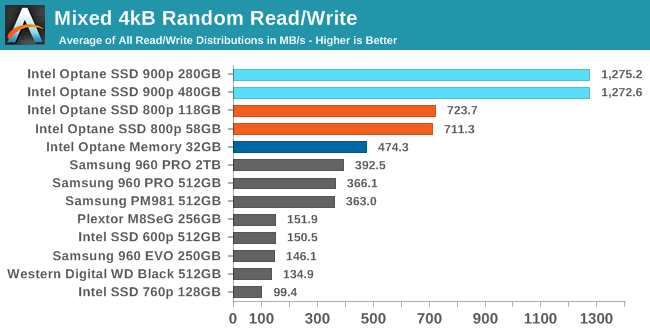
The Optane SSDs put even Samsung's best NVMe SSDs to shame on the mixed random I/O test. The 800p is a little more than half as fast as the 900p, which is plenty to put it far out of reach of the flash-based SSDs.
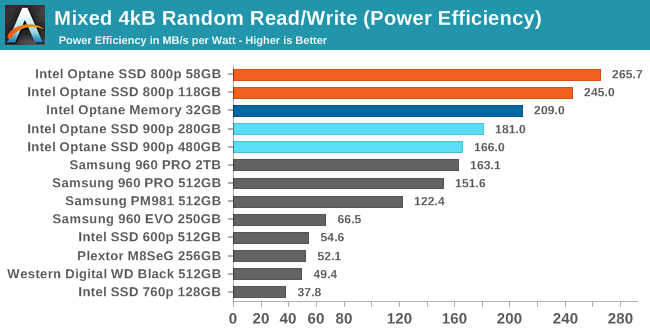
The Optane SSD 800p takes first place for power efficiency on the mixed random I/O test, with the 58GB model having a slight advantage over the 118GB due to the lower power consumption of operating half as many 3D XPoint dies. The flash-based SSDs come close to matching the efficiency of the Optane SSD 900p, but are far behind the 800p.
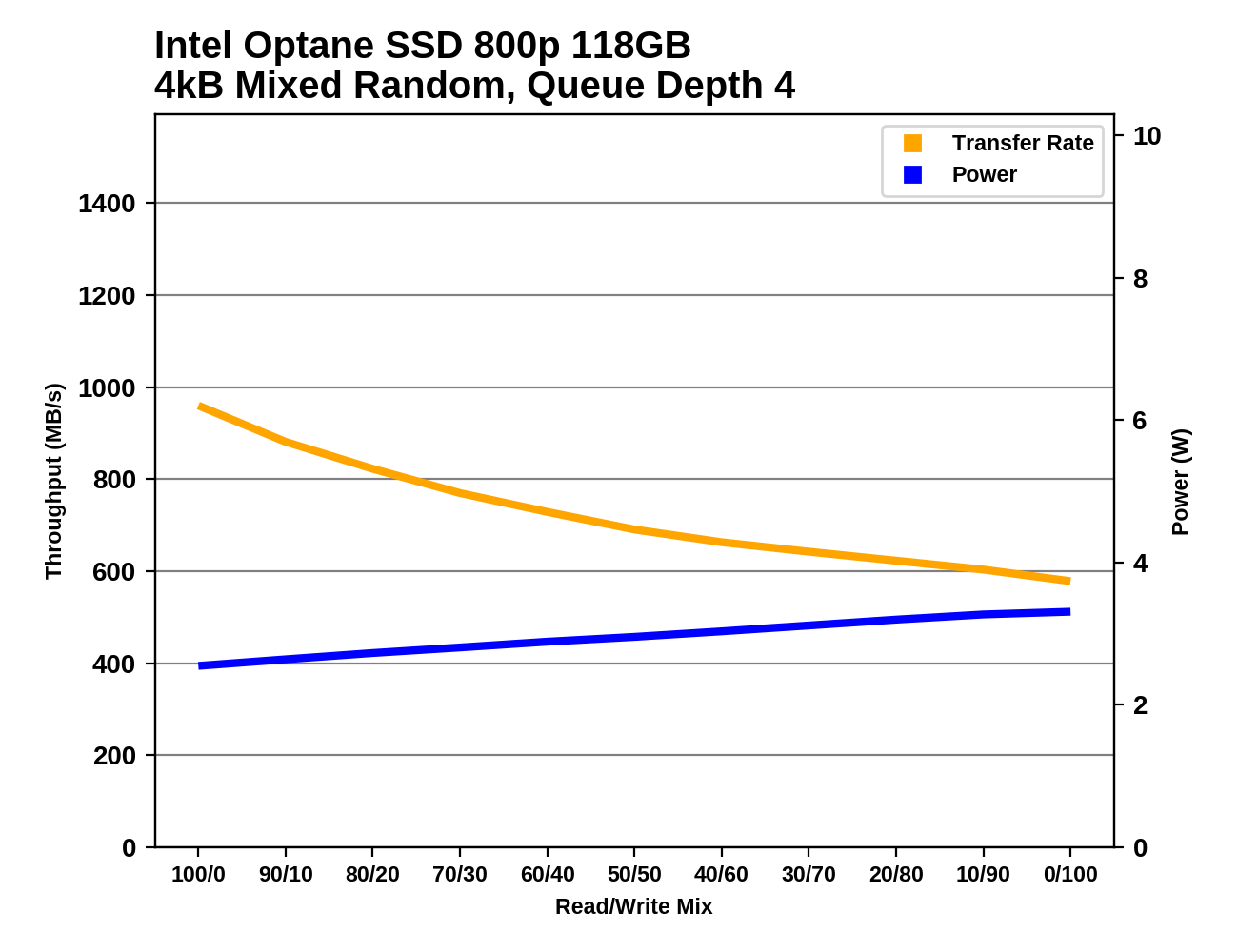 |
|||||||||
With no write buffering, the Optane SSDs show a steady decline in performance as the proportion of writes increases, with no spike in performance at the end as is typical of flash-based SSDs with aggressive write combining. The 800p shows a more pronounced reduction in performance than the 900p, while the 900p's power consumption climbs more.
Mixed Sequential Performance
Our test of mixed sequential reads and writes differs from the mixed random I/O test by performing 128kB sequential accesses rather than 4kB accesses at random locations, and the sequential test is conducted at queue depth 1. The range of mixes tested is the same, and the timing and limits on data transfers are also the same as above.
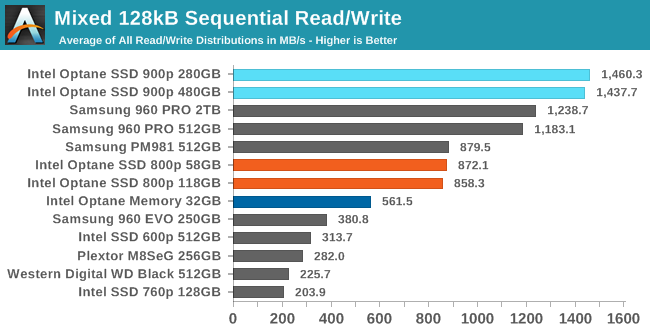
With only a PCIe x2 interface and sequential write speeds that only use a fraction of that bandwidth, the Optane SSD 800p is actually performing pretty well on the mixed sequential I/O test. The 800p has the same average performance as Samsung's fastest TLC SSD, and offers more than two thirds the performance of the Samsung 960 PRO.
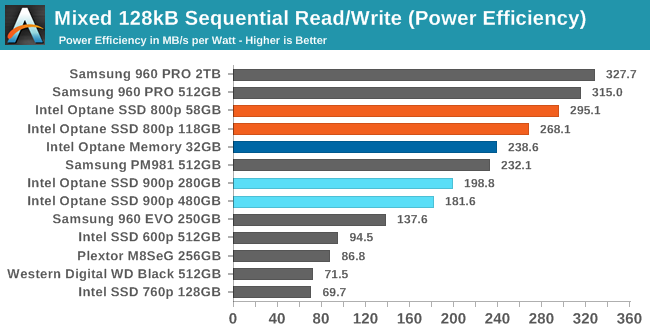
The power efficiency of the Intel Optane SSD 800p is second only to that of the Samsung 960 PRO. The 800p's efficiency score is far above the 900p and the low-end NVMe SSDs.
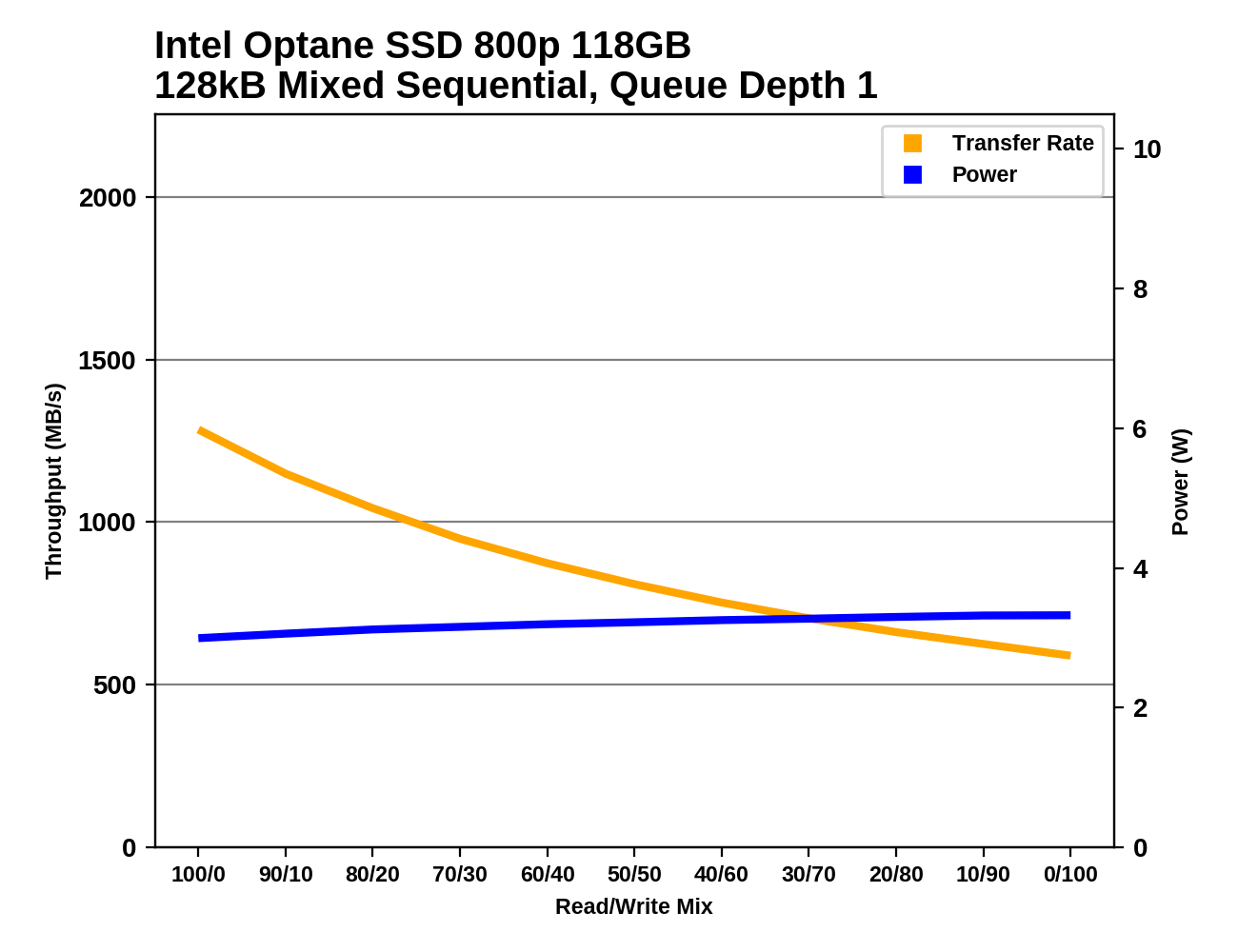 |
|||||||||
As with the mixed random I/O test, the Intel Optane SSD 800p shows a steady decline inn performance as more writes are added to the mix. The decline is steeper than the one shown by the 900p. Power consumption increases very slightly over the course of the test but still stays within the rated maximum.










116 Comments
View All Comments
Hurr Durr - Thursday, March 8, 2018 - link
Hypetane!iter - Thursday, March 8, 2018 - link
optane = hypetanex-point = xtra-pointless
It keeps getting worse and worse instead of getting better. The next x-point iteration may slip below nand even in the few strong points of the technology.
Also, it doesn't seem that enterprise is very interested in intel's offering, seeing how they struggle to cram the product in market niches where it is xtra-pointless, I'd go on a limb and assume that's not because of love for consumers or skipping on them fat enterprise product margins.
Also, it seems that intel gave very misleading information not only in terms of performance, but also regarding the origin of the technology. The official story is its development began in 2012 as a joint venture between intel and micron.
That however is not true, x-point can be traced back to a now erased from history company named Unity Semiconductors, which was flogging the tech back in 2009 under the CMOx moniker.
Courtesy of archive.org, there is still some trace of that, along with several PDFs explaining the operational principle of what intel has been highly secretive about:
https://web.archive.org/web/20120205085357/http://...
All in all, the secrecy might have to do with intel's inability to deliver on the highly ambitious expectations of the actual designers of the tech. It is nowhere near the 200% better than nand density, in fact it seems at the current manufacturing node it won't be possible to make more than 256 gb in m2 form factor, which is 8 times less than mlc nand or 24 times less than what was projected in 2009. Performance is not all that stellar too, a tad lower than what slc was capable at back in 2012, thank the gods nobody makes slc anymore, so there's a ray of sun to make xtra-pointless hypetane look good on paper.
chrnochime - Thursday, March 8, 2018 - link
Rambus renamed it to ReRAM according to this article in 2015, so it would seem the tech lived on through Rambus after the aquisition of Unity Semi.https://www.eetimes.com/document.asp?doc_id=132552...
But I'm not sure if it's the exact same tech as Intel's.
iter - Thursday, March 8, 2018 - link
Check the PDFs, what little intel posted about it is all there. They may have licensed the tech from rambus. It is not like rambus does anything other than patent milking anyway.iter - Thursday, March 8, 2018 - link
"Coincidentally", rambus bought unity in 2012, exactly when intel allegedly started developing...MDD1963 - Friday, March 23, 2018 - link
Not everyone remembers a few sticks of RAMBUS RDIMMS for some Pentium 3 boards costing $500-$600 a stick back in '99-'00....; and being outperformed by DDR. Nice job, RAMBUS!tommo1982 - Thursday, March 8, 2018 - link
Am I reading it right? Was Cross-point memory supposed to be cheaper than NAND?WinterCharm - Thursday, March 8, 2018 - link
Yes. But I guess we won't see that for a while.Latency and power consumption are great... but speed and capacity leave a lot to be desired. When MacBook Pros have NVME drives capable of 3.2 GB/s (yes gigabytes) at a 2TB capacity... Optane is far behind.
There are some advantages, but I expect that Intel will need to do a lot more work before these are cheaper, faster, and have higher capacity.
Reflex - Friday, March 9, 2018 - link
That said, latency is what users notice. Max speed is a rarely encountered scenario in most user workloads.iter - Saturday, March 10, 2018 - link
No human notices microseconds. Delay becomes noticeable at about 10-20 msec, depending on the individual's reflexes, becomes annoying at about 50 msecs, and becomes detrimental at 200+.10 mseconds is 10000 microseconds. Hypetane improves things in the double digit microseconds range. Humans cannot notice that, not today, not in a million years.